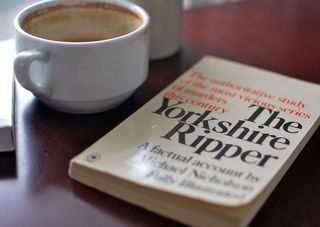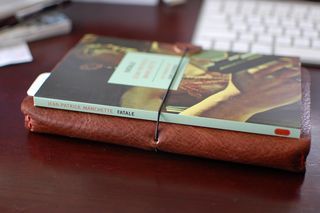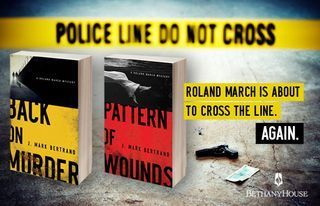J. Mark Bertrand's Blog, page 8
May 11, 2011
I was a Teenage Detective
This is my badge. I wore it with pride for a few weeks on the mean Louisiana streets as a steely-eyed boy of fifteen.
Yes, I was a teenage detective.
Perhaps "apprentice" is a better word, since my duties mainly involved hanging out with a private eye and serving as willing audience for his many stories. There was some surveillance, too, which was a lot like storytelling, only the stories were told while sitting in a car watching an apparently empty house.
I had a second badge, too, but it was stolen.
Sadly, my one investigation was personal, and ended in failure. You can read all about it in my essay on the subject: "Mark Bertrand, Boy Detective."
May 10, 2011
Notes on (Another) Craft

Writers spend their lives with pen in hand, making the most of whatever paper happens to be available when inspiration strikes. The actual work takes place on the computer more often than not, but pen and paper is still the most efficient way to make notes. (Although I have been known to send myself an e-mail when all else fails.) Not surprisingly, I've experimented with every sort of notebook. Recently I've settled on using Moleskine cahier notebooks, which have stitched bindings and craft paper covers. The paper isn't great, but it's all right, and they happen to be readily available.
Inspired by Tanzo, I've even made a few leather covers to hold multiple cahiers by means of elastic. My work isn't anywhere near as polished, but in the off hours when I'm not working on a book, I have managed to get slightly competent with leather. The cover in the photo is my latest piece of work.
One side of my office is covered in paper. The other is littered with scraps of leather. The result is chaos, but at least I can tell myself that my profession and my hobby are mutually supporting.
May 9, 2011
A Book to Catch the Yorkshire Ripper
Thanks to Red Riding, I've had the Yorkshire Ripper on the brain, which explains why journalist Michael Nicholson's "authoritative study" ended up in my shopping bag. What I didn't realize at the time was that Nicholson's book was published in 1979, two years prior to the arrest and conviction of the Ripper, Peter Sutcliffe. The book concludes with a "Chronology of Murdered Women" which ends with the twelfth victim, Barbara Leach. Sutcliffe would claim two more victims before he was stopped.
In fact, Leach was not the twelfth victim at all. Nicholson's chart includes Joan Harrison as the second victim thanks to her mention in the first Wearside Jack letter, which police had not yet realized was a hoax by the time of publication. DNA evidence finally unmasked the identity of the hoaxer in 2005, and earlier this year DNA comparison also solved the mystery of Leach's murder, though too late to bring the killer to justice.
Given the publication date, it's not surprising that Nicholson's concluding chapter is subtitled "How to Spot the Ripper." Here he indulges in a little psychological profiling:
By his actions, the Ripper suggests to me a certain tactical expertise, a background of military training and a disciplined approach .... His ability to melt into the darkness almost suggests guerilla training .... The long intervals between murders could possibly be explained by service tours overseas .... It would probably be best to start with regiments which draw a significant proportion of their recruits from the region where it is felt the Ripper originates. The First Battalion Royal Regiment of Fusiliers, the King's Own Border Regiment and the Scottish Borderers are given merely as examples of where to look.
In fact, Sutcliffe was a lorry driver. "I hope that some of the ideas contained here," Nicholson wrote, "may provoke a thought or a recollection which will lead to the murderer." It didn't happen that way, but as a historical artifact, and a testament to how far off the investigation was, this account makes for interesting reading.
May 6, 2011
Doc Noir Prescribes Some Yellow Medicine
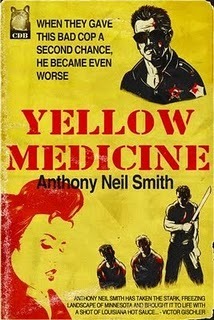
Anthony Neil Smith (i.e., Doc Noir) opened his reading at the South Dakota Festival of the Book last year by quoting Flannery O'Connor's dictum that, to the hard of hearing, you shout ... and then proceeded to demonstrate with a story that pretty much roared. His Billy Lafitte novels Yellow Medicine and Hogdoggin' struck a chord with me on a couple of counts. For one, Lafitte is (like me, and like Smith) a Southern boy transplanted to the Midwest. Second, he's an anti-hero. As Smith says in an interview today at Criminal-E, with Lafitte he wanted to "make an unsympathetic character irresistibly engaging."
Well, it worked.
I'm a sucker for unsympathetic characters. When the topic came up last May at Mayhem in the Midlands, I gave the example of Ken Bruen's White Trilogy, starring the ever-unlikeable DS Brant. Lafitte's in that territory. You want him to stay bad. With the e-book priced at just $1, introducing yourself to the crooked deputy is a no-brainer. (And speaking of bad, how about that cover? Bad to the bone. The original from the Bleak House edition was fine, but the retro-pulp look is perfect.)
May 5, 2011
Charles Williams: Pulp on the High Seas
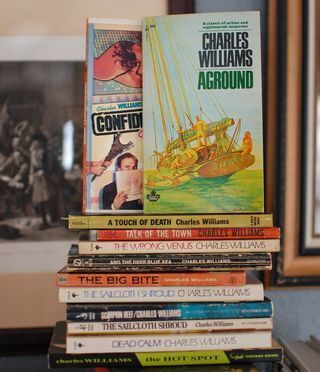
Thanks to the movies, Charles Williams was a favorite of mine before I knew he existed. Truffaut's last film, Confidentially Yours (originally Vivement dimanche!) -- which I loved -- was based on Williams' The Long Saturday Night. And his novel Dead Calm was turned into a movie thriller which introduced the world to Nicole Kidman. It was another favorite of mine, but not for her sake. Anything starring Sam Neil during the post-Reilly, Ace of Spies to pre-Jurassic Park era is on my list of wonders. He made a great John Ingram and would have been even better if the movie had hewn closer to the line of the book.
It never occurred to me in the late 80s that these movies might have had novels behind them. (The connection was made a bit harder by the fact that there's another novelist named Charles Williams, a compatriot of C. S. Lewis, with whom I was familiar.) Once I made the discovery, though, I started devouring the entire Williams opus, as the photo above suggests.
He started by writing tightly-plotted pulp novels featuring hard luck men and femme fatales. Somewhere along the way, he moved the action onto the water. It's a great combination. In Dead Calm, he takes the babes and brawls already known to appeal to male readers and adds celestial navigation. I can barely navigate with a GPS unit, and yet I was riveted every time Ingram had to make a compass adjustment in his head. And Dead Calm is actually the second novel featuring Ingram. He and his future wife Rae first meet in Aground, which is quite good, too. Predictable as it is to declare the book better than the movie, in the case of Dead Calm, it really is.
I wouldn't say the same about The Long Saturday Night. Truffaut takes the jumbled plot and makes it highly entertaining, adapting the Texas setting to French locales without much trouble, resulting in a black-and-white homage to noir that ditches the dark tone and seems the better for it. Then again, maybe it's just the fact that Fanny Ardant is in the lead.
May 4, 2011
More from Manchette: Fatale + Like a Sniper...
Members of the Jean-Patrick Manchette Cult have plenty to get excited about this year. Fatale, the third of his novels to appear in English, has been released by New York Review Books, the translation undertaken by Donald Nicholson-Smith, the translator responsible for Three to Kill, published by City Lights Noir in 2002. I've been carrying my copy around (as pictured), stealing a few pages here and there. Fatale numbers fewer than a hundred pages, so I don't want to rush.
More anticipation: Jacques Tardi's graphic novel version of Manchette's The Prone Gunman, which has been given the slightly more poetic title Like a Sniper Lining Up His Shot, is due out this summer. Reading the earlier effort, an edition of Three to Kill (dubbed West Coast Blues), I was surprised how well the story was adapted to the medium. It's not for the faint of heart, however, and I imagine Like a Sniper will be no different.
May 3, 2011
Roland March Crosses the Line
The official release date for Pattern of Wounds, the second March novel, is about eight weeks away, so naturally some promo stuff is coming online. There are also going to be some changes at jmarkbertrand.com. If you visit now, for example, you can download a PDF version of the four-color brochure devoted to Pattern of Wounds.
April 5, 2011
What Does The Killing Remind Me Of?
I stayed up late Sunday night to catch the replay of AMC's much-anticipated new series The Killing, and it did not disappoint. When it comes to television, American fans of crime fiction don't have all that much to be proud of. We put out a lot of quantity, but not a lot of quality. You can only point to The Wire so many times without coming off as a one-note. So despite its foreign pedigree, I'm hoping The Killing will stick around, and will inspire more of the same.
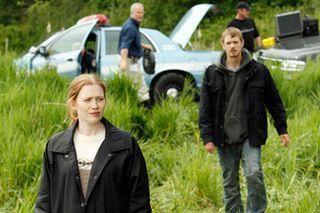
Above: Cops in search of a crime.
The reason so many people are comparing The Killing to The Wire is that it employs the same series-arc approach. Most crime shows have an episodic structure; each week there's a new murder to solve. The Pacific northwest setting has led to some Twin Peaks references, too, but The Killing is serious in tone rather than quirky. It's moody and atmospheric, though (unlike The Wire, which favored a certain blunt realism).
Having a whole season to unpack the story gives The Killing a more novelistic feel. Instead of shoehorning the whole process into forty-five minutes worth of rushed sound bites in the manner of Law & Order, the show can have more weight, more "duration." AMC's promotional effort seems to understand that, for an American audience, this can be a turn-off. They're trying extra-hard to keep us hooked.
For all the comparisons, there is one match noticeably absent. The show I kept thinking of while watching the first two episodes of The Killing was not The Wire, it was Five Days, the BBC series that follows "five non-consecutive days (days 1, 3, 28, 33 and 79) of a police investigation into the disappearance of a young mother and her two children." I'm a sucker for the whole 'story of the investigation' approach, in contrast to the whodunnit, and if The Killing turns out to be anywhere near as good as Five Days was, I will be most pleased.
March 31, 2011
Writing About Reprobation
I've written an article for the Spring issue of By Faith titled "Writing About Reprobation: The Theological Value of Noir Fiction." In the print edition, the title alone takes up a two-page spread, with a fedora-wearing hardboiled model banging away on a typewriter. The online version doesn't show as much undershirt:
For the full argument, click the link and enjoy. Here's a little taste from near the end ...
Compared to the real world, noir fiction is highly stylized. But next to the stylized world of the classic detective tale with its drawing rooms and butlers and obscure poisons, the hard-edged world of noir seems real indeed. Chandler is best understood in the context of Christie, and noir's insistence on total corruption is best understood in the context of a world that insists on its fundamental justice and orderliness.
Many thanks to the folks at By Faith for devoting so much space to my little riff on the virtues of noir.
March 18, 2011
Pattern of Wounds ARCs Arrive
A box from my publisher arrived this morning containing a handful of Advanced Reading Copies of my next Roland March crime novel, Pattern of Wounds. When the ARCs for Back on Murder came out, I remember thinking something along the lines of, "I guess this is for real." This time I'm a little better prepared! Here's how they look:
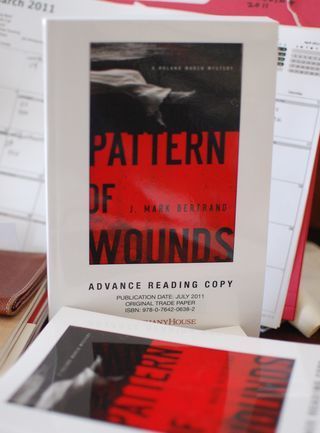
The second cover takes its cues from the first, which means that the March books should look nice on a shelf next to one another. First yellow, now red ... I wonder if the third one will be green?


